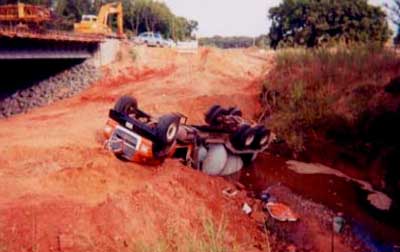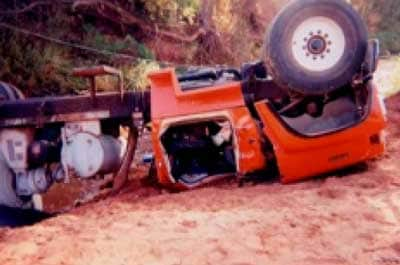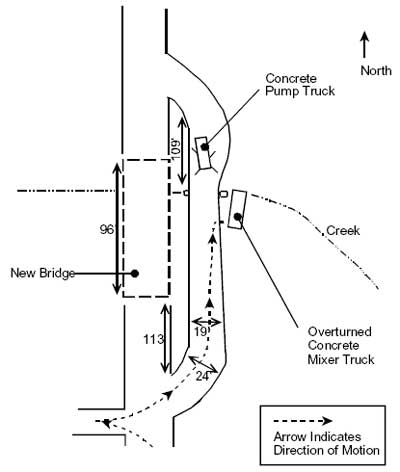Truck Driver Died When Concrete Mixer Truck Overturned
Oklahoma Case Report: 00-OK-073
Summary
A 43-year old truck driver died on October 5, 2000 from injuries received when the concrete mixer truck he was driving overturned into a creek bed. OKFACE investigators concluded that to prevent similar occurrences, employers should:
- Conduct a thorough hazard review in preparation for road construction activities to identify hazards and risks that need to be eliminated and/or controlled.
- Utilize a competent engineer and apply proper engineering principles to the design and construction of any temporary haul road where critical hazards and risks have been identified.
- Ensure that engineering specifications for any temporary haul road include inspection and maintenance requirements appropriate for the environmental conditions and intended use of the road.
- Establish written policies that require vehicle operators to inspect any temporary road or other off-road terrain before attempting to drive a vehicle in such locations.
- Establish written policies that require vehicle operators to obtain the assistance of a guide when backing vehicles into or through hazardous areas.
OKFACE investigators also suggest development of a health and safety management system for multiple employer work sites that enables adequate planning, implementation, monitoring, correction, and continual improvement of work site health and safety with universal participation by all subcontractors and employees operating at the site.
Introduction
A 43-year old truck driver died on October 5, 2000 from injuries received when the concrete mixer truck he was driving overturned into a creek bed. The driver was working for a ready-mix concrete company supplying concrete for a bridge construction contractor. He had worked for the company for two years. OKFACE investigators reviewed the death certificate, the medical examiner’s report, the Official Oklahoma Traffic Collision Report filed by the investigating Oklahoma Highway Patrol trooper, the medical flight transport service report, and Occupational Safety and Health Administration reports. While conducting the site survey the investigators interviewed the ready-mix plant manager. OKFACE investigators also interviewed representatives of the State Department of Transportation and experts in road construction safety and civil engineering.
 |
| Figure 1. Overview of Work site |
The ready-mix company had been in business for a total of forty-two years with the last three under current ownership. It employed a total of ten persons at the time of the incident. The company was contracted to supply concrete to the bridge construction site that was located approximately seventeen miles from the ready-mix site. The company had delivered concrete in the early stages of the project but had not been to the site for almost three months prior to the week of the incident. The project had been halted for two months as the bridge contractor waited on the delivery of concrete beams to construct the bridge deck. The driver had not previously hauled concrete to the site. The truck driven by the deceased was the first of six concrete mixer trucks to be dispatched to the site on the day of the incident.
The victim was driving a concrete mixer truck that was eight feet wide and had a gross vehicle weight of 66,000 pounds. The truck was fully loaded with ten yards of concrete at the time of the incident. The vehicle was subjected to periodic preventive maintenance and routine daily equipment inspection; it was inspected and determined to be in good operating condition prior to the incident. The driver had extensive experience with the vehicle, and he was a driver trainer for the ready-mix company. The company had a written safety program; however, certain aspects of the program were not contained in the written program, including policies that may have affected the outcome of the incident. The company had a formal job training program in place, and each driver was subjected to competency testing upon completion of the program. The facility employees participated in a monthly formal safety meeting and other informal safety meetings as were deemed necessary for any particular job.
Investigation
The incident occurred on a low water temporary “haul” road that was constructed approximately four months prior to the incident on the east side of the bridge as a means to move equipment and materials across the creek between the north and south sides of the project. The low water bridge consisted of a three-foot diameter culvert positioned in the creek bed. It was 318 feet in length, ranged from 19 to 24 feet in width, and was constructed of compacted indigenous earth to a level approximately four feet above the top of the culvert (7-8 feet above the creek bed). Post incident analysis of the haul road materials indicated a 57% sand and 43% percent clay mixture (Unified Soil Classification System Type sandy clay soil). Post-incident penetrometer tests indicated relatively good compaction toward the center of the road but extremely low shear strength at the shoulder. Investigators found that the material at the edge of the road crumbled easily to the touch.

|
|
Figure 2. Close View of Crushed Truck Cab
|
Low shear strength at the road shoulder, the underlying cause of the incident, was attributable to a lack of cohesion resulting from the absence of moisture in the road material. The area was experiencing a serious drought at the time with the last significant rainfall having occurred in July. A crane (100,000 pound estimated gross vehicle weight) and a truck carrying the bridge beams (112,000 pound estimated gross vehicle weight) had crossed the haul road on September 27, a concrete mixer truck had used the road on October 2, and a concrete pumper truck (82,000 pound estimated gross vehicle weight) had crossed the road earlier on October 5, all apparently without incident. Although witness accounts described some superficial work on the haul road performed by a dozer immediately prior to the incident, OKFACE investigators could find no objective evidence that the temporary road had been specifically engineered for the environmental or use conditions to which the road was to be subjected nor that it had been routinely inspected or maintained.
The deceased reported for work on the morning of October 5 at 6:00 a.m. to prepare for a bridge deck concrete pour that was scheduled for 7:30 that morning at the bridge site. His truck, the first of six to be dispatched to the site that day, was loaded and he left for the bridge site at approximately 7:00 a.m. The concrete pumper truck that was to be used to pump concrete from the mixer trucks up to the bridge deck arrived at the south side of the bridge site at about 7:20 a.m. The pumper truck driver indicated to the bridge contractor foreman that additional staging space would be needed at the setup point near the north end of the haul road to accommodate the vehicle’s outriggers and pads. The foreman instructed a dozer operator to make the necessary alterations to the haul road, which he completed a few minutes later. When the dozer work was completed, the pumper truck driver crossed the low water bridge and positioned his vehicle near the north end of the haul road. When the first concrete mixer driver (the victim) arrived at the south side of the site, he contacted the superintendent of the bridge contractor for instructions. The superintendent instructed him to wait at the turn-around point at the south end of the bridge until the pumper truck was set up. The second concrete mixer truck also waited while the pumper truck was positioned and set up for the pour.
As the pumper truck driver and bridge contractor personnel were completing the pumper truck setup, the bridge contractor foreman instructed the first mixer driver to turn his truck around and prepare to back across the low water bridge. The driver positioned his vehicle squarely in the haul road and began backing down the incline toward the low water bridge. There was conflicting information on whether or not someone was guiding him as he backed the truck. As the truck reached the low water bridge, a bridge contractor employee observed the truck backing at an angle to within three feet of the east edge of the road, and he shouted a warning as the truck began to slide toward the edge of the road. The second mixer truck driver, who had exited his truck to position the chute, saw the first truck starting to slide and saw the driver attempt to exit the vehicle on the passenger side. The truck hesitated, then rolled over into the creek bed as a section of the road, measuring approximately twelve feet in length and five feet in width, sheared off the road shoulder and collapsed into the creek (Figure 1 and 2). The mixer drum flipped completely over, landing upside-down in the creek bed and slamming the cab into the steep (approximately 45°) creek bank. The impact crushed the roof of the cab and trapped the driver inside the vehicle. The incident occurred at approximately 7:55 a.m.
Several witnesses rushed to the truck to assist the driver and at least two called 911 to report the incident. At least two individuals also contacted the ready-mix company. Workers at the bridge site attempted to extricate the driver by removing the crushed passenger-side door with a pry bar. Unable to free the driver, they tried to communicate with him but the victim was unresponsive. The local fire department arrived approximately ten minutes after the incident, and a medical flight aircraft arrived shortly thereafter. Fire department personnel reported a weak pulse upon arrival, but no pulse was indicated upon extrication of the victim from the vehicle about 50 minutes later. When attempts to resuscitate the victim were unsuccessful, he was pronounced dead at the scene.

|
|
Figure 3. Bridge Project Haul Road and Vehicle Positions
|
Cause of Death
The Medical Examiner listed the probable cause of death as head and neck injuries.
Back to Top
Recommendations/Discussion
Recommendation # 1: Employers should conduct a thorough hazard review in preparation for road construction activities to identify hazards and risks that need to be eliminated and/or controlled.
Discussion: Although the types of hazards that caused the fatal incident are fairly common in road construction, each project and operation can potentially present uncommon or unusually serious hazards and risks. Hazard reviews often provide an opportunity to determine a better approach in response to an actual or potential problem identified in the process. For example, after the incident occurred, the project managers elected to position the pumper truck on the south side of the bridge thereby eliminating the necessity for the pumper and mixer trucks to cross the low water bridge. While certain operational disadvantages or difficulties may have accompanied this strategy, its implementation prior to the concrete pour may have reduced or eliminated hazardous operations and prevented the fatal incident altogether.
Recommendation #2: Employers should utilize a competent engineer and apply proper engineering principles to the design and construction of any temporary haul road where critical hazards and risks have been identified.
Discussion: Temporary haul roads are not subject to the same rigorous design specifications and standards as public roadways because they are not subject to public vehicle traffic; however, safe use of these roads is nonetheless dependent on proper design and construction. OKFACE investigators did not identify any objective evidence that the haul road in use at the time of the fatal incident had been constructed in accordance with appropriate engineering specifications. The haul road design made no provisions for lateral stability of the road base subsequent to any significant degradation such as that resulting from critical moisture loss. Haul roads should be designed in accordance with the intended use and environmental conditions anticipated throughout the duration of the project with particular consideration for the actual and potential hazards and risks presented by those conditions.
Recommendation #3: Employers should ensure that engineering specifications for any temporary haul road include inspection and maintenance requirements appropriate for the environmental conditions and intended use of the road.
Discussion: OKFACE investigators determined that rehabilitation of the road surface did not correct defects in the road structure caused by the long drought and consequent absence of moisture in the soil. The width of the road and the width of the truck provided a 5.5-foot clearance on both sides of the vehicle, but the shear strength of the road declined dramatically toward the road’s edge. As the truck veered from the middle of the road toward the east edge of the road, the combined weight of the vehicle and load imposed on the road shoulder in its structurally compromised condition caused the collapse of the road and consequent overturn of the vehicle. The high center of gravity of the truck and load caused the vehicle to rotate 180° into the creek bed, and the height of the mixer created a fulcrum that allowed the weight of the front of the vehicle to slam the roof of the cab into the creek bank. The driver was consequently crushed inside the cab of the vehicle.
Moisture content bears a direct relationship to the shear strength of a compacted sandy clay soil and therefore the structural integrity of the road constructed of this material. The effect of the drought conditions on the integrity of the road could have been lessened by replacing moisture in the road materials so as to maintain the optimum moisture content. However, design specifications should include monitoring and measurement techniques and preventive and corrective maintenance to prevent the type of deterioration that occurred in the road used by the vehicle at the time of the incident.
Post-incident investigation found that the road materials readily crumbled to the touch at the edges of the haul road and possessed virtually no shear strength at the road’s shoulder. Inclusion of relevant routine inspection requirements, accompanying employee training for identifying signs of deterioration, and clear assignment of responsibility for performing the inspections and addressing identified deficiencies should be included in the road specifications.
Recommendation #4: Employers should establish written policies that require vehicle operators to inspect any temporary road or other off-road terrain before attempting to drive a vehicle in such locations.
Discussion: The ready-mix company had an unwritten policy that drivers inspect off-road areas in which they are to drive their vehicles; however, OKFACE investigators could find no objective evidence that the deceased driver performed such an inspection before starting down the haul road. Because the pumper truck had preceded his own attempt to cross the low water bridge without incident, he may have presumed that no hazard existed, particularly given the fact that the gross vehicle weight of the pumper truck exceeded that of his mixer truck by about 16,000 pounds. Employers should establish such requirements in writing to better ensure conformance and periodically monitor work operations to measure employee conformance to the requirements.
Recommendation #5: Employers should establish written policies that require vehicle operators to obtain the assistance of a guide when backing vehicles into or through any hazardous area.
Discussion: Witness accounts of the incident conflict as to whether anyone was in position to guide the driver as he backed his vehicle down the haul road to the low water bridge. An individual guiding the driver as he backed the vehicle down the haul road may have had an opportunity to halt the operation before the truck veered a significant distance from the center of the road. Employers should establish written requirements for use of a guide when backing a vehicle into or through actual or potentially hazardous conditions and periodically monitor work operations to measure employee conformance to the requirements.
References
- 29 CFR 1926.601, Motor vehicles.
- 29 CFR 1926.602, Material handling equipment.
- Budhu, M. Soil Mechanics and Foundations. Wiley & Sons: 2000.
- Cernica, J.N. Geotechnical Engineering: Soil Mechanics. Wiley & Sons: 1995.
- Winterkorn et al. Foundation Engineering Handbook. Van Nostrand Reinhold: 1975.
Oklahoma FACE Program
The Oklahoma Fatality Assessment and Control Evaluation (OKFACE) is an occupational fatality surveillance project to determine the epidemiology of all fatal work-related injuries and identify and recommend prevention strategies. FACE is a research program of the National Institute for Occupational Safety and Health (NIOSH), Division of Safety Research.
These fatality investigations serve to prevent fatal work-related injuries in the future by studying the work environment, the worker, the task the worker was performing, the tools the worker was using, the energy exchange resulting in injury, and the role of management in controlling how these factors interact.
To contact Oklahoma State FACE program personnel regarding State-based FACE reports, please use information listed on the Contact Sheet on the NIOSH FACE website. Please contact In-house FACE program personnel regarding In-house FACE reports and to gain assistance when State-FACE program personnel cannot be reached.
